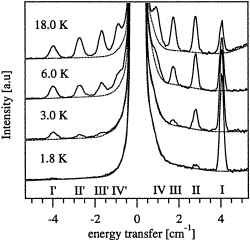Abstract of Publication No. 369
 Hanspeter Andres, Reto Basler, Hans-Ulrich Güdel, Guillem Aromi, George
Christou, Herma Büttner and Benoit Rufflé
Hanspeter Andres, Reto Basler, Hans-Ulrich Güdel, Guillem Aromi, George
Christou, Herma Büttner and Benoit Rufflé
Inelastic Neutron Scattering and Magnetic Susceptibilities of
the Single-Molecule Magnets [Mn4O3X(OAc)3(dbm)3]
(X=Br, Cl, OAc and F): Variation of the Anisotropy along the Series.
J. Am. Chem. Soc. 122, 12469-12477 (2000)
![]()
![]()
Abstract:
The single-molecule magnets (SMMs) [Mn4O3X(OAc)3(dbm)3]
(X=Br, Cl, OAc and F) were investigated by a detailed inelastic neutron scattering
(INS) study. Up to four magnetic excitations between the
zero-field split levels of the lowest S=9/2 cluster ground-state
have been resolved. From the determined energy-level diagrams
and the relative INS intensities we can show that the inclusion
of a rhombic term in the zero-field splitting (ZFS) Hamiltonian
is essential in these compounds. On the basis of the
Hamiltonian: HZFS = D[Sz2-1/3S(S+1)]
+ E(Sx2-Sy2) + B40O40,
the following sets of parameters are derived: For X = Cl: D =
-0.529cm1, |E| = 0.022cm1, and B40
= -6.5e-5cm1; for X = Br: D = -0.502cm1,
|E| = 0.017cm1, and B40 =
-5.1e-5cm1; for X = OAc: D = -0.4.69cm1,
|E| = 0.017cm1, and B40 =
-7.9e-5cm1; and for X = F: D = -0.379cm1
and B40 = -11.1e-5cm1. The
wave functions derived from the energy analysis are in excellent
agreement with the relative intensities of the observed INS
transitions. The observed temperature maxima of the out-of-phase
component of the variable freqency AC magnetic susceptibility Tmax[chi'']
correlate well with the energy splittings determined by INS.
Direct information about the rate of quantum tunneling is
contained in the cluster wave functions derived in this study.
The difference in the quantum tunneling between X = Cl and Br is
shown to be directly related to differences in the rhombic
anisotropy parameter |E|.